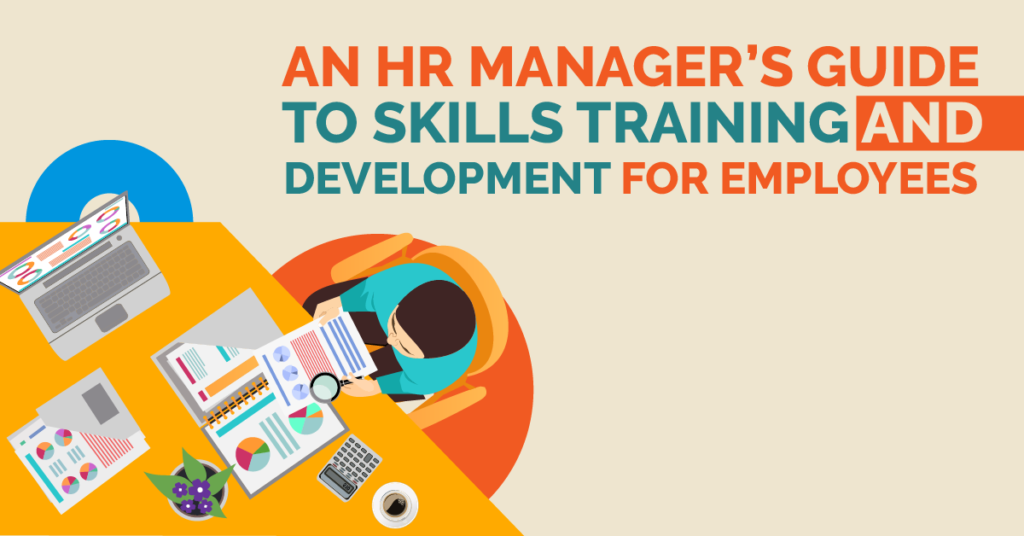
Employees are the most valuable asset of any company. More than the revenue generated or material resources, employees’ time, skills, and efforts matter the most. It’s through their commitment and contributions that businesses earn and progress.
Acquiring competent employees alone isn’t enough. Even if businesses hire candidates with the right background and skill sets, they won’t flourish without proper training and development. They don’t just help new hires become familiar with their roles; it also makes employees old and new feel valued and compel them to continue working for your company.
This infographic will guide you on developing skills training and development for employees.

Employee Training and Development
Employee training and development are vital processes that guide your team toward familiarizing themselves with their roles. Through proper guidance, your company can mold employees into competent and confident individuals. While they may sound the same, there are key differences between training and development.
Training involves short-term activities that provide employees with the necessary skills for a specific task. Studying market trends, learning about technological and industrial changes, and developing soft skills fall under employee training. These activities help them understand their roles better and maximize their potential.
Meanwhile, development comprises long-term activities focusing on widening employees’ skill sets and knowledge. It strengthens areas such as leadership, communication, and professional growth.
Benefits of Employee Training and Development
Good employee training and development sets the tone for how employees learn about their respective roles. Your company’s goals and objectives also constantly shift due to various demands, and continuous learning keeps your employees sharp. Here are five benefits that come with employee and training development:
1. Increases employee retention
Good companies know how to hire employees, but the great ones take care of and retain them. Treating your employees with respect and providing optimal training encourages them to commit to your company. Individual growth is also more achievable.
TeamStage found that 40% of job resignations are due to inadequate employee training. Losing employees doesn’t just reduce your workforce; it also costs a lot because recruitment and hiring use up money and are time-consuming. By prioritizing your employee’s development, you keep them happy and gain their loyalty.
2. Improves company reputation
Job hunters, especially millennials and Gen Zs, desire fulfilling careers and welcome growth, which is possible through employee training and development. In fact, 29% of millennials and Gen Zs prefer working for companies with learning and development opportunities. The more you put your employee’s interests first, the better they become at their roles.
3. Eliminates micromanagement
Micromanagement is the enemy of productivity. A survey shared by SlingShot shows that 69% of employees opt to switch jobs due to micromanagement issues. By holding employee training and development, you enable them to work independently and boost their morale. Moreover, they maintain focus and accomplish tasks efficiently.
4. Increases productivity
Employee productivity is determined by how well they understand their roles and the quality of their training. Workers can accomplish tasks and projects more efficiently if they undergo a successful employee training program.
According to Seismic, companies with employee training have highly engaged employees and acquire 24% higher profit than companies without training. High-quality training is the bridge to more effective employees and more revenue.
5. Develops future leaders
According to Lorman, 60% of millennials seek leadership training. Teaching your employees supplies them with vital leadership skills they’ll need for future roles. Pursuing qualified candidates is a quick way to acquire leaders, but training current employees to fit leadership roles nurtures their talents and adds to their value.
How to Create an Employee Training and Development Program
A training plan is a major part of preparing new employees for their roles. It should cover all they need to know and how to carry out tasks with minimal supervision. Here are five ways to craft an effective employee training and development program:
1. Identify company goals
Start by knowing what company goals should be met. The skills your employees will learn should align with these goals. Once these goals are plotted, the next step is assessing areas employees need to sharpen and excel at.
2. Interview your employees
It pays to know your employees more. Apart from objectives and skill sets, it’s also good to ask about their current challenges (internal or external) and areas they want to improve on. Acquiring insights can help you adjust your training program. The most important thing is for employees to learn in the best ways possible.
3. Set the objectives of the program
Think about what you want your employees to achieve at the end of their training. Do you want them to become well-versed in handling multiple clients? Should they master three to four technical skills during their first six months at work?
Conduct a gap analysis on your employee’s current performance versus their desired outputs. This process is useful because it helps set program objectives based on factors such as competitor analysis, the level of expertise of current employees, and the new skills needed.
4. Select the right training and development methods
Not all training methods are suitable for every task. Choose training methods that are relevant to your employee’s roles. Take the time to weigh out the pros and cons of each and employ the ones most beneficial to their learning.
5. Measure the results
Progress is measured through how well employees learn during their training. Monitor their output per training session. It’s critical to know which training methods work and which ones don’t.
Adjustments should also be made accordingly. If there are lessons that aren’t easy to grasp, simplify them. The most important result is how well they can apply what they learned to their roles.
Challenges of Remote Training and Development and How to Overcome Them
Remote work is advantageous for those that prefer working from home or anywhere with a good internet connection. Although it’s practical and provides flexibility, remote work isn’t immune from problems, especially when it comes to remote training and development. Here are four challenges you may face.
1. Distractions
Remote work can lead to various distractions, such as browsing the web, chatting with friends, and even doing nothing. Employees lose focus and procrastinate.
To keep your employee’s attention, consider integrating a dynamic learning design through tests, quizzes, and other similar activities to make training sessions more engaging. That way, your employees are mentally stimulated while engaging with the content.
2. Scheduling problems
Scheduling meetings can be a headache if you’re working with people across the globe. The different time zones can be confusing, making meetings, presentations, and other activities difficult to plan.
Familiarize yourself with the schedules of employees based abroad to eliminate scheduling conflicts. Set a specific number of hours for meetings with agendas to enhance productivity.
3. Technical problems
Not all employees have access to the same types of resources required for stable online training. Low-spec computers, poor internet connections, and other hindrances can be detrimental to conducting smooth training sessions.
Upgrade to a better internet subscription plan. Purchase a computer with updated specifications. Subsidize your employees’ internet and/or devices (even partially) or provide company-issued devices that can handle their workflow. If you’re hosting the training sessions, encourage employees to chat or call you for any clarifications. Addressing these technical issues can ensure better quality for online training sessions.
4. Feelings of isolation
Although you get to see people online, remote work doesn’t give you that natural feeling that only face-to-face interactions can. Spending hours in front of a screen can affect productive learning.
Lessening feelings of isolation is possible through creating a learning environment. Assign group reviews of projects and ongoing tasks. You can also schedule online social engagements after work to get to know each other more.
Employees Training and Development Tools
Having the right tools is a must for training your employees. These tools allow for structured and easy learning, which helps you track their progress. Here are five tools you should incorporate into your training program:
1. Online learning platforms
Online learning platforms are filled with educational content with a wide range of topics. Some are membership-based, but others offer free learning without any registration. Platforms such as HubSpot and Google Digital Garage offer free online courses to help you further your learning outside work.
2. Collaboration tools
Collaboration tools are apps or software programs that simplify work processes so that team members can work together more efficiently. Managers and employees can assign tasks, update project progress, and improve internal and external workflows using these. Microsoft Team, Google Meet, and Zoom are examples of collaboration tools.
3. Learning management system
This software implements and evaluates a specific learning process. It allows instructors to track participation, create and share content, and assess performance. A learning management system also provides trainees feedback through forums, video conferencing, and threaded discussions. One example you can use is TalentLMS.
4. Project management tools
These tools manage groups and individual team members by enabling scheduling, collaboration, evaluation, and documentation. Some good project management tools to use are Trello and Asana.
5. Audio and video tools
Audio and video tools are effective because they give employees the freedom to watch or listen to recorded sessions from any device. Recording tips to follow or even meshing screenshots with audio are great ways to get your lessons across. Some video tools that you can use for mobile learning are Audacity and Loom.
Charting the Path to Long-Term Success
As a business owner, you must understand that building long-term success entails taking care of your employees. You can’t neglect the significance of providing sufficient skills training and healthy development.
Your employees want to be successful and well-rounded members. That can only happen through strategically crafting employee training programs, making remote work conducive to their learning, and using the right training tools.
Manila Recruitment is a headhunting executive recruitment firm that specializes in hiring highly skilled Filipino talent. Looking to recruit new talent? Contact us for more details!













